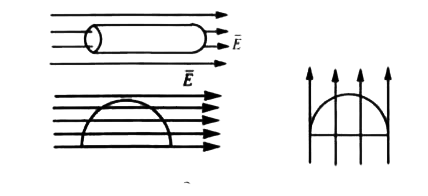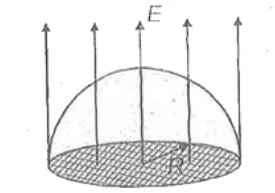A cylinder of radius R and length L is placed in a uniform electric field E parallel to the axis. The total flux for the surface of the cylinder is given by
To find the total electric flux through the surface of a cylinder placed in a uniform electric field E that is parallel to the axis of the cylinder, we can follow these steps:
1. Identify the Geometry of the Cylinder:
- The cylinder has a radius R and a length L.
- The electric field E is parallel to the axis of the cylinder.
2. Identify the Surfaces of the Cylinder:
- The cylinder has two circular surfaces (top and bottom) and one curved surface.
- Let's denote the top circular surface as Surface A, the bottom circular surface as Surface B, and the curved surface as Surface C.
3. Determine the Orientation of the Electric Field:
- The electric field E is parallel to the axis of the cylinder, which means it is parallel to Surfaces A and B.
- The electric field is perpendicular to the curved surface C.
4. Calculate the Electric Flux through Each Surface:
- The electric flux Φ through a surface is given by the formula:
Φ=E⋅A⋅cos(θ)
where A is the area of the surface and θ is the angle between the electric field and the normal to the surface.
5. Calculate Flux through Surface A:
- The area of Surface A (circular) is:
AA=πR2
- Since the electric field is parallel to Surface A, θ=0∘ and cos(0)=1:
ΦA=E⋅AA=E⋅πR2
6. Calculate Flux through Surface B:
- Similarly, for Surface B, the area is also πR2 and the electric field is parallel:
ΦB=E⋅AB=E⋅πR2
7. Calculate Flux through Surface C:
- The area of the curved surface C is 2πRL.
- The electric field is perpendicular to Surface C, so θ=90∘ and cos(90)=0:
ΦC=E⋅AC⋅cos(90)=0
8. Sum the Total Flux:
- The total electric flux Φtotal through the surface of the cylinder is the sum of the fluxes through all three surfaces:
Φtotal=ΦA+ΦB+ΦC=E⋅πR2+E⋅πR2+0=2E⋅πR2
Final Result
The total electric flux for the surface of the cylinder is:
Φtotal=2EπR2
- The cylinder has a radius R and a length L.
- The electric field E is parallel to the axis of the cylinder.
- The cylinder has two circular surfaces (top and bottom) and one curved surface.
- Let's denote the top circular surface as Surface A, the bottom circular surface as Surface B, and the curved surface as Surface C.
- The electric field E is parallel to the axis of the cylinder, which means it is parallel to Surfaces A and B.
- The electric field is perpendicular to the curved surface C.
- The electric flux Φ through a surface is given by the formula:
Φ=E⋅A⋅cos(θ)
where A is the area of the surface and θ is the angle between the electric field and the normal to the surface.
- The area of Surface A (circular) is:
AA=πR2
- Since the electric field is parallel to Surface A, θ=0∘ and cos(0)=1:
ΦA=E⋅AA=E⋅πR2
- Similarly, for Surface B, the area is also πR2 and the electric field is parallel:
ΦB=E⋅AB=E⋅πR2
- The area of the curved surface C is 2πRL.
- The electric field is perpendicular to Surface C, so θ=90∘ and cos(90)=0:
ΦC=E⋅AC⋅cos(90)=0
- The total electric flux Φtotal through the surface of the cylinder is the sum of the fluxes through all three surfaces:
Φtotal=ΦA+ΦB+ΦC=E⋅πR2+E⋅πR2+0=2E⋅πR2
The total electric flux for the surface of the cylinder is:
Φtotal=2EπR2
Topper's Solved these Questions
- ELECTROSTATICSBOOK - DC PANDEY ENGLISHCHAPTER - ELECTROSTATICSEXERCISE - Example Type 5
5 Videos
- ELECTROSTATICSBOOK - DC PANDEY ENGLISHCHAPTER - ELECTROSTATICSEXERCISE - Example Type 6
4 Videos
- ELECTROSTATIC POTENTIAL AND CAPACITORSBOOK - DC PANDEY ENGLISHCHAPTER - ELECTROSTATIC POTENTIAL AND CAPACITORSEXERCISE - (C) Chapter exercises
50 Videos
- GRAVITATIONBOOK - DC PANDEY ENGLISHCHAPTER - GRAVITATIONEXERCISE - All Questions
135 Videos
Similar Questions
A cylinder of radius R and length l is placed in a uniform electric field E parallel to the axis of the cylinder. The total flux over the curved surface of the cylinder is
View SolutionConsider a cylindrical surface of radius R and length l in a uniform electric field E. Compute the electric flux if the axis of the cylinder is parallel to the field direction.
View SolutionIn a uniform electric field find the total flux associated with the given surfaces

View SolutionA Gaussian surface in the cylinder of cross-section πa2 and length L is immersed in a uniform electric field E with the cylinder axis parallel to the field. The flux ϕ of the electric field through the closed surface is
View SolutionA hollow half cylinder surface of radius R and length l is placed in a uniform electric field →E. Electric field is acting perpendicular on the plane ABCD. Find the flux through the curved surface of the hollow cylindrical surface

View SolutionA hemispherical surface of radius R is kept in a uniform electric field E as shown in figure. The flux through the curved surface is

View SolutionA hemispherical body of radius R is placed in a uniform electric field E. What is the flux linked with the curved surface if, the field is (a) parallel to the base, (b) perpendicular to the base.
View SolutionA hemispherical body of radius R is placed in a uniform electric field E. What is the flux linked with the curved surface if, the field is (a) parallel to the base, (b) perpendicular to the base.
View Solutiona hemispherical hollow body is placed in a uniform electric field E. the total flux linked with the curved surface is

View Solutiona hemispherical hollow body is placed in a uniform electric field E. the total flux linked with the curved surface is

View Solution
